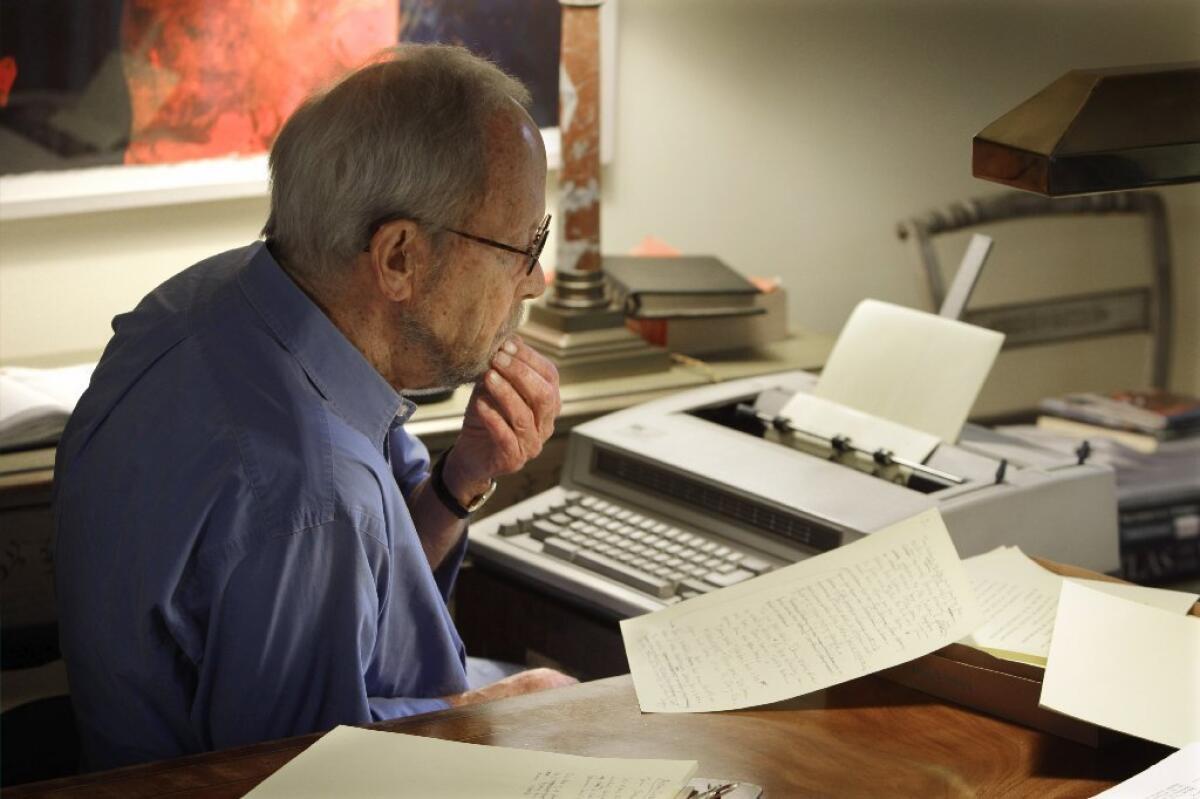Appreciation: Elmore Leonard’s unique voice lives on in ‘Justified’

- Share via
Elmore Leonard, the highly popular and well-regarded crime novelist who died Tuesday at age 87, also left his mark on television. Compared with his books and the movies that continue to be wrought from them, it’s the smallest of the marks he made: Two of the three TV series based on his writing, “Maximum Bob” (ABC, 1998) and “Karen Sisco” (ABC, 2003), didn’t survive even a single season, though they deserved more. (Both came from Barry Sonnenfeld, who produced the big-screen Leonard adaptation “Out of Sight,” another Karen Sisco story; and directed “Get Shorty,” the film that by Leonard’s own reckoning made him a household name.)
But the third series is FX’s “Justified,” based on Leonard’s 2001 novella “Fire in the Hole,” which has won a Peabody Award and has lasted four years with a fifth on the way. And is great.
Leonard’s association with television goes all the way back to 1956 and the “Schlitz Theater” adaptations of his Saturday Evening Post short story, “Moment of Vengeance,” one of the many Western tales he wrote before turning to crime fiction in the late 1960s. Later, in the afterglow of “Get Shorty,” there were two serviceable 1997 TV movies, made from his “Gold Coast” and “Pronto,” the latter the book that introduced “Justified” main character Raylan Givens (played there by James LeGros, and now by Timothy Olyphant).
PHOTOS: Elmore Leonard | Career in pictures
Yet, with some signal exceptions, including the original teleplays for the 1980 “High Noon Part Two: The Return of Will Kane” (with Lee Majors in the Gary Cooper role) and the 1987 “Desperado” (a failed pilot that spawned four non-Leonard sequels), he did little screenwriting himself. To be sure, he gave his adapters everything they needed -- vivid characters, colorful
situations and an abundance of highly speakable dialogue. He was like Agatha Christie in that way: Straightforward, suggestive and made for television.
His legacy to the medium, however, is less a matter of raw material than of a voice. As crime writers go, Leonard strikes me as not so much hard- as medium-boiled: He wrote with a sense of fun and an amused affection for his villains as well as his heroes -- they just have different
wavelengths on a spectrum of flawed humanity.
It’s a voice that “Justified,” which combines the two strains of Leonard’s writing life -- Raylan is essentially a frontier marshal in (mostly) modern eastern Kentucky -- captures brilliantly. The show is an act of imitation and extrapolation, as in an Old Master’s workshop: School of Leonard.
PHOTOS: Notable deaths of 2013
Showrunner Graham Yost gave his writers Leonard’s novels so they could learn his voice and bracelets inscribed “WWED” for “What Would Elmore Do.” Leonard, for his part, seems to have been more than usually available and involved.
For his 2012 novel “Raylan,” inspired by the series that he inspired, Leonard included characters that had been created by the TV writers, along with Boyd Crowder (Walter Goggins’ likable criminal antagonist), whom the author had killed off in “Fire in the Hole,” the novella that became the pilot for “Justified.” (Leonard had wisely suggested to Yost that he keep the
character alive for the series.) Reciprocally, Yost has used material from “Raylan” in “Justified.”
A column Leonard wrote for the New York Times in 2001, much cited over the last couple of days, offered 10 rules “to help me remain invisible when I’m writing a book.” They boil down to simple prose without much detail or description and leaving out “the part that readers tend to skip.”
PHOTOS: Behind the scenes of ‘Justified’
To Leonard, this meant using dialogue to define character and carry the story. His people acquit themselves ultimately through their actions, but surrounding and accompanying that action is conversation, with every voice making its own particular music. Before the bullets or the fists fly, there is talk, and there is talk afterward, and sometimes during.
On cursory inspection, Raylan may look like the strong, silent archetype -- one way to describe him is as a man who is continually drawn into conversations he’d rather not have and that go on longer than he’d like. Everyone on “Justified” likes to have the last word.
So the master is gone. But the pupils remain. And the voice maintains.
More to Read
The complete guide to home viewing
Get Screen Gab for everything about the TV shows and streaming movies everyone’s talking about.
You may occasionally receive promotional content from the Los Angeles Times.







